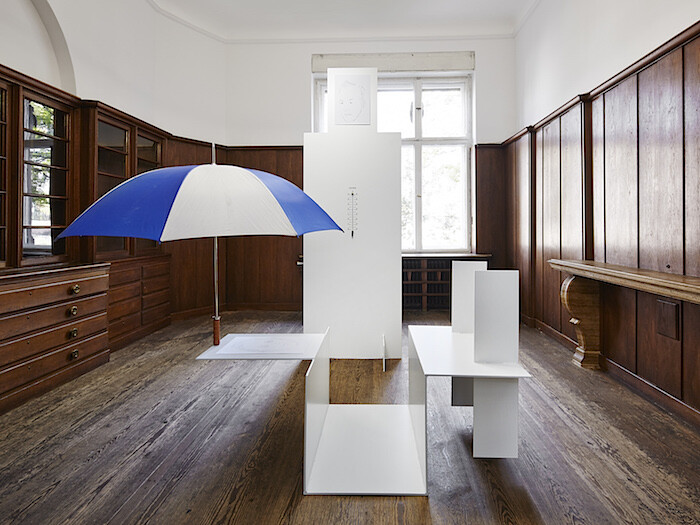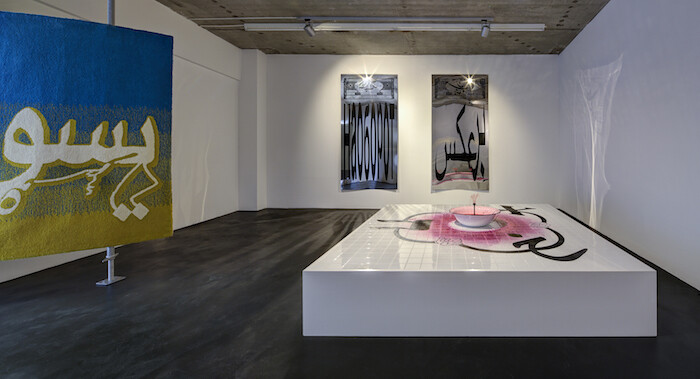Categories
Subjects
Authors
Artists
Venues
Locations
Calendar
Filter
Done
February 28, 2024 – Review
Tania Bruguera’s “Where Your Ideas Become Civic Actions (100 Hours Reading The Origins of Totalitarianism)”
Eugene Yiu Nam Cheung

In Germany’s increasingly censorious intellectual climate, Berlin’s Hamburger Bahnhof staged the Cuban artist Tania Bruguera’s “Where Your Ideas Become Civic Actions (100 Hours Reading The Origins of Totalitarianism)” inside its main hall. This participatory public reading of—and discussion around—Hannah Arendt’s The Origins of Totalitarianism (1951) was spread across four days, featuring the artist alongside writers such as Masha Gessen and Deborah Feldman, prominent artists in Berlin including Candice Breitz, and people from “the museum’s neighborhood.”
Speakers—mostly solo, sometimes in a trio, and even as a chorus—addressed the audience amid a spare scenography: a single rattan-upholstered rocking chair, illuminated from above by a beam of golden light. Hospital-gray bean bags and cardboard stools were strewn before it, stretching out towards the entrance of the museum and luring visitors into a collectivized consideration of “power and violence, plurality and morality, politics and truth.”
Microphones were connected to a sound system scattered haphazardly around the space, and synchronized with speakers outside the institution facing Invalidenstraße, a thoroughfare leading to Berlin’s central station, a few hundred meters away. Like the work’s title, Bruguera’s sonic gesture felt prescriptive—as if it were the artist’s duty to break Arendt out of the institution and onto the …
September 24, 2021 – Feature
Berlin Roundup
Emily McDermott

Since the beginning of last year many artists have turned inward—or at least towards their immediate surroundings. Last week, during Berlin Art Week and Gallery Weekend Berlin’s Discoveries edition, over 70 exhibitions (some long-delayed) opened in the city’s galleries, institutions, project spaces, and private collections, featuring both established and emerging artists. The themes addressed are wide-ranging, but one recurring motif is an introspection expressed in portraiture: not necessarily in the figurative sense, but in using the framework of an exhibition to present a close study of one’s own identity, of a place, of an environment.
Reflecting this idea most overtly is Alicja Kwade’s exhibition “In Abwesenheit (In Absence)” at Berlinische Galerie. Here, the artist moves away from her usual cosmic explorations of time in favor of a show that is most clearly read as a self-portrait. 314,000 sheets of pale purple paper are printed with her fully sequenced DNA, with the 0.1% of letters that differentiate her from others bolded. Many sheets line the room’s towering walls, while thousands more are encased in bronze archival boxes. Twenty-four speakers are arranged on a giant black steel ring suspended from the ceiling, projecting Kwade’s heartbeat as it rises and falls. Bronze molds …
September 20, 2016 – Feature
Berlin Roundup
Matthew Evans

Berlin affluence is an oxymoron that might describe something in the big gap between pilsner and champagne, or pork schnitzel and sous-vide. Events like Berlin Art Week and its commercial fair abc art berlin contemporary have been pushing the German capital onto the national and international buyers’ tour for nine years now. It remains an odd positioning, as Berlin isn’t an obviously digestible city for many collectors; it lacks their creature comforts: the ubiquity of restricted access and unaffordable prices with enough locals who can afford to keep them that way. And art fairs (not to be confused with life) are most successful—and most distracting—when the rich feel hungry and foot the bill for the entertainment. But it’s an important exercise to distinguish between wealth and security (not to be confused with fear). The former is an uncertain orgasm of contrasts, which has become aesthetic cliché, while the latter is more interesting and maybe even radical today. Without the pressure (and pleasure) of fast and fat capital in recent history, Berlin has profited from this advantage, and although events like abc might be experimenting to revise that, the city still remains at one remove, which is a privilege, because the …
November 9, 2015 – Review
Slavs and Tatars’ “Dschinn and Dschuice”
Ana Ofak

On the occasion of their nomination for the Preis der Nationalgalerie in 2015, Slavs and Tatars’ work can presently be viewed at two locations in Berlin. One is the Hamburger Bahnhof, the institution hosting the prize. There, books by the art collective are offered up for viewing in what looks like a swingers’ club for bookworms. By now, Slavs and Tatars have published ten books, making these the heart of their production. The other exhibition is at Kraupa-Tuskany Zeidler. Although the gallery show lacks the legs that lure and the dangling swings of the Hamburger Bahnhof presentation, it is far more daring. Together, the two sites unlock the universe of holistic heuristics Slavs and Tatars have been constructing for almost a decade. In this universe, the veils of obscurity that fell over the Eurasian territory, covering it in a neoliberal economy of uniform individualism, are lifted.
Slavs and Tatars are supreme wordsmiths. Hardly another letter in the pool of Slavic languages of Eurasia requires so much artistry in articulation or, for that matter, causes so much transcription trouble in the West as the Dž or Dż [d͡z] in the exhibition’s title. But “Dschinn and Dschuice” does not simply poke fun at …
June 11, 2011 – Review
"based in Berlin"
Michèle Faguet

As the debate over the alleged mishandling of the mysterious E. coli outbreak in Germany raged on in the local and international press, Berliners had their own little controversy to distract themselves with: the opening of the mega-exhibition “based in Berlin,” warily anticipated (and even boycotted) by many members of the local art community distrustful of the motives behind the project’s conception. First presented in October 2010 as a Leistungsschau (showcase) of the much-touted contemporary art scene in Berlin, this survey exhibition was headed up by Christine Macel, Hans Ulrich Obrist, and Klaus Biesenbach as the first step in a long-term initiative to eventually establish a permanent Kunsthalle in Berlin—a decades old issue that has become a significant part of the political agenda of Mayor Klaus Wowereit (of “poor but sexy” fame).
Protests were quick to follow the open-call for artists in Berlin to submit their portfolios, and soon thereafter a group of young “under-curators” (Angelique Campens, Fredi Fischli, Magdalena Magiera, Jakob Schillinger, Scott Cameron Weaver) were appointed to run around town doing the dirty footwork, hopping from studio to studio in a huff-and-puff attempt to get this (vaguely defined) show off the ground. A series of heated discussions hosted by …